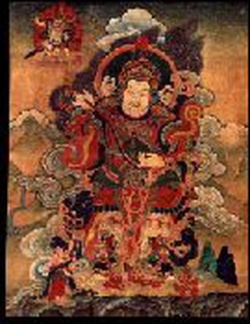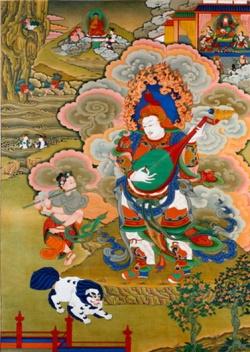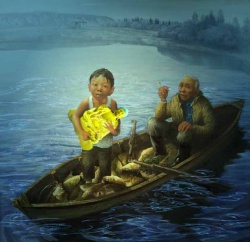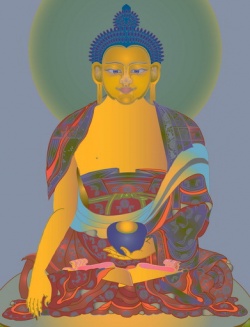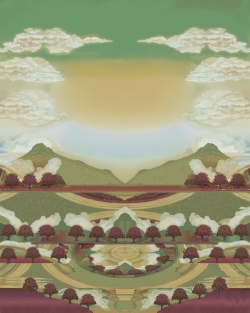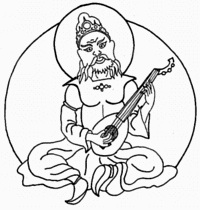Dhritarashtra
- One of the Four Great Kings
- A major character from the Mahabharata
1. One of the Four Great Kings
Dhritarashtra (Skt. Dhṛtarāṣṭṛa; Tib. Yulkhor Sung; Wyl. yul 'khor srung; Eng. 'Defender of the Area') is the Guardian King of the East and chief of the gandharvas, the musicians of the heavens.
In a previous life he and Virudhaka were nagas. Filled with fear of the garudas, the great bird-like beings who prey on the nagas, they would not stir from the bottom of the ocean, but upon hearing of Buddha Kashyapa’s teaching, they took refuge in the Dharma. From then on their virtue protected them from harm and they lived, free of fear, on the ocean's surface.
Whatever sound he hears is turned back, causing harm to whoever produced it, therefore he covers his ears with his helmet and plays a stringed instrument so that he will not hear any other sounds.
Further Reading
- Crystal Mirror, volume VI, Dharma Publishing 1984
2. A Major Character from the Mahabharata
In the Mahābhārata , Dhritarashtra (Skt. dhritarāshtra) was the son born to Vichitravirya's first wife Ambika. This blind king of Hastinapura was father to a hundred children by his wife Gandhari. These children came to be known as the Kauravas.
Source
Upholder of the Nation;
持国天 (Skt Dhritarashtra; Jpn Jikoku-ten);
One of the four heavenly kings of Buddhist mythology. This god is said to live halfway up the eastern side of Mount Sumeru and protect the eastern quarter. In Buddhist scriptures, Upholder of the Nation often appears as a guardian of the Buddha's teachings and a protector of the uposhadha 792 world along with the other three heavenly kings, Wide-Eyed, Hearer of Many Teachings (also known as Vaishravana), and Increase and Growth.
Source
Dhritirastra (Ch’i-Kuo Tien-Wong): Heavenly King of the East and the gandharvas, who is usually white in color and often depicted holding a sword and/or a lute or stringed musical instrument.
Source
Dhritarashtra is the white king of the East and of the Gandharvas or celestial musicians holding a lute. Often in the centre is the golden yellow guardian of the North, king of the Yakshas, Vaishravana (Tib: Nam Toseh) holding a victory banner.
Source
The sons of Diti, the four Maharajas kings of the directions with Dhritarashtra at their head; the hosts of Yogins with the king Drumasiddha, the (heavenly) ascetics, the Vasus, the Manus; the children of the forest [the beasts], the creatures of the waters headed by the Makara, the birds headed by Garuda, and all the kings in the different worlds with the Lord of the Tushita heaven at their head, and [also] those in the world of the dead -- the domain of Bali ---whatever is conspicuous in the universe, the Holy One created it all by becoming the Universal One.
Source
White, lute-playing Dhritarashtra, (Tib. Yul Khorsung) King of the East is called Chiguo in Chinese. Jikoku, in Japanese. In Buddhism, music is acknowledged as a medium that can help teach the dharma also subdue negativity.
Source
Dhritarashtra (Tibetan: yul khor srung), Guardian of the Eastern Direction and King of the Gandharva - celestial musicians.
Dhritarashtra, leader of the Gandharva heavenly musicians, is a worldly guardian worshipped as a protector. He lives on the east side of the lower slopes of mount Meru in the Heaven of the Four Great Kings. Like the other Direction Kings, the leader Vaishravana, Virupaksha and Virudhaka, he swore an oath of protection before the buddha Shakyamuni. The stories and iconography of the Four Guardian Kings arose originally with the early Buddhist sutras and became fully developed with the later Mahayana. They are common to all schools of Tibetan Buddhism. Paintings of the Kings are generally found in association with a larger thematic set featuring the buddha Shakyamuni and the 16 Great Arhats.
Source
Dai Jikoku Tenno or Dhritarashtra ~ Heavenly King of the East Dhritarashtra is one of the four heavenly kings. Buddhism describes Dhritarashtra as follows: "This guardian king governs in the east and presides over the spring. He is ‘He who maintains the kingdom (of the Law)’. ‘the maintainer of the state’…He commands an army of celestial musicians (Gandharvas) and vampire demons (Pisaca)." The Gandharvas are one of the eight kinds of supernatural beings who are said to revere and protect the Dharma.
According to the Kumarajiva translation of the Lotus Sutra, it is Dhritarashtra who offers dharanis in chapter twenty-six for the benefit of the teachers of the Lotus Sutra.
Icon: A helmeted warrior wearing armor and wind-blown scarves. He has a green complexion and a wrathful expression. He holds a sword in his right hand and his closed left hand rests on his hip.
Source
Dhṛtarāṣṭa means "watcher of lands".
King of the East. White in colour, holding a lute. King of the Gandharvas (celestial musicians). Dhṛtarāṣṭa means "watcher of lands".
There is a king Dhṛtarāṣṭra in the Mahābhārata. The war amongst his children and those of his younger brother Pāndhu for the throne of the Kurus - the Kauravas and the Pāndavas - forms the main action of the Mahabhārata war around which the epic revolves (Basham : 408). It is thought that the story recount a real war, although the dates are disputed.

oṃ dhṛ ta rā ṣṭra ra lā pra vā dha na svā hā
oṃ dhṛtarāṣṭra ralāpravādhana svāhā
I have followed the spelling of Bonji Taijkan which I think is correct, but have also seen "dhṛtarāśtra" and "dhṛtarāṣṭṛa" in reputable sources.
Source
